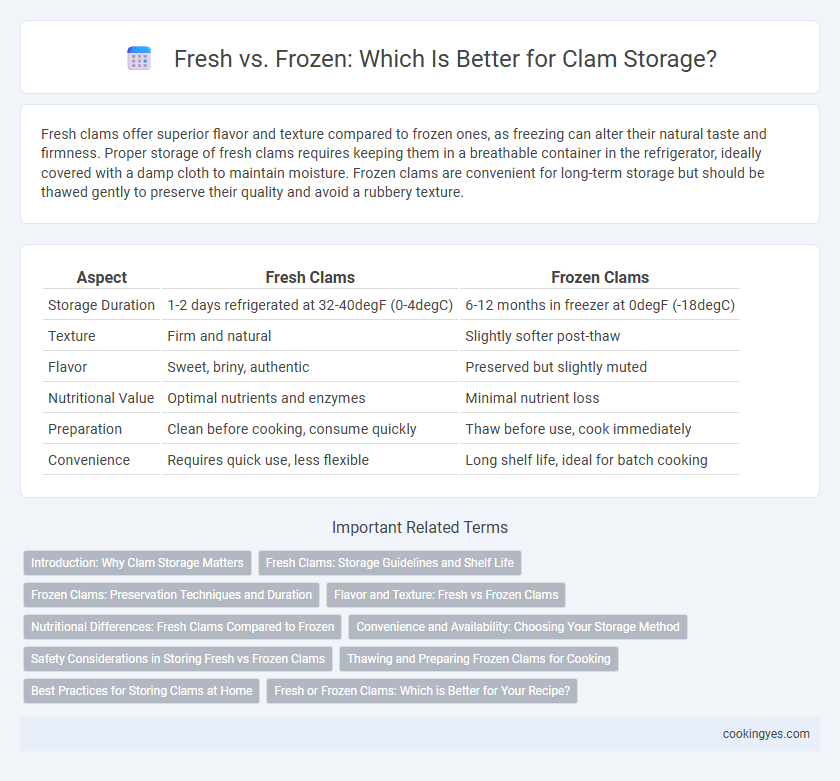Fresh clams offer superior flavor and texture compared to frozen ones, as freezing can alter their natural taste and firmness. Proper storage of fresh clams requires keeping them in a breathable container in the refrigerator, ideally covered with a damp cloth to maintain moisture. Frozen clams are convenient for long-term storage but should be thawed gently to preserve their quality and avoid a rubbery texture.
Table of Comparison
| Aspect | Fresh Clams | Frozen Clams |
|---|---|---|
| Storage Duration | 1-2 days refrigerated at 32-40degF (0-4degC) | 6-12 months in freezer at 0degF (-18degC) |
| Texture | Firm and natural | Slightly softer post-thaw |
| Flavor | Sweet, briny, authentic | Preserved but slightly muted |
| Nutritional Value | Optimal nutrients and enzymes | Minimal nutrient loss |
| Preparation | Clean before cooking, consume quickly | Thaw before use, cook immediately |
| Convenience | Requires quick use, less flexible | Long shelf life, ideal for batch cooking |
Introduction: Why Clam Storage Matters
Proper clam storage preserves freshness and ensures food safety by preventing bacterial growth and spoilage. Fresh clams stored at temperatures between 32degF and 40degF maintain optimal texture and flavor, while freezing clams at 0degF extends shelf life but may alter their natural taste and firmness. Choosing the right storage method impacts the quality and culinary value of clams in recipes and commercial distribution.
Fresh Clams: Storage Guidelines and Shelf Life
Fresh clams should be stored in a breathable container covered with a damp cloth to maintain moisture and prevent suffocation, ideally placed in the coldest part of the refrigerator at temperatures between 32degF and 40degF. The optimal shelf life for fresh clams is generally 1 to 2 days, as prolonged storage increases the risk of spoilage and bacterial growth. Proper handling, including discarding any clam with a broken shell or that fails to close when tapped, ensures safety and preserves quality.
Frozen Clams: Preservation Techniques and Duration
Frozen clams maintain optimal freshness through rapid freezing techniques such as blast freezing, which preserve their texture and flavor by preventing ice crystal formation. Properly stored at -18degC or below, frozen clams can retain quality for up to 3 to 4 months without significant nutrient loss. Vacuum-sealing enhances shelf life by reducing exposure to air and preventing freezer burn during long-term storage.
Flavor and Texture: Fresh vs Frozen Clams
Fresh clams offer superior flavor and a tender, chewy texture prized by seafood enthusiasts, while frozen clams may experience slight changes, becoming firmer or somewhat rubbery after thawing. The freezing process can dull the natural briny sweetness and reduce the nuanced taste that fresh clams provide. For optimal flavor and texture, fresh clams harvested within 24 hours deliver the best culinary experience, whereas frozen options remain a convenient alternative with minor compromises.
Nutritional Differences: Fresh Clams Compared to Frozen
Fresh clams retain higher levels of vitamin B12 and omega-3 fatty acids compared to frozen clams, which may experience nutrient degradation during the freezing process. Protein content remains relatively stable between fresh and frozen clams, but moisture loss in frozen clams can slightly alter texture and flavor. Minerals like zinc and iron are preserved well in both forms, ensuring essential nutrient intake regardless of storage method.
Convenience and Availability: Choosing Your Storage Method
Fresh clams offer superior flavor and texture but require immediate consumption or refrigeration within 24 hours to maintain quality. Frozen clams provide extended shelf life and convenient availability year-round, making them ideal for long-term storage and spontaneous use. Prioritizing frozen clams ensures easy portioning and reduces spoilage risk, while fresh clams deliver optimal taste for planned meals.
Safety Considerations in Storing Fresh vs Frozen Clams
Fresh clams require refrigeration at temperatures below 40degF (4degC) and should be consumed within 24 hours to minimize bacterial growth and foodborne illness risks. Frozen clams, stored at 0degF (-18degC) or lower, maintain safety for extended periods by halting microbial activity and enzymatic degradation. Proper handling, including keeping fresh clams in breathable containers and avoiding temperature fluctuations in both fresh and frozen storage, is crucial for food safety.
Thawing and Preparing Frozen Clams for Cooking
Thaw frozen clams in the refrigerator for 12 to 24 hours to maintain freshness and prevent bacterial growth. After thawing, rinse clams thoroughly under cold water to remove ice crystals and any debris trapped in the shells. Prepare thawed clams by steaming or sauteing promptly to preserve their texture and flavor.
Best Practices for Storing Clams at Home
Fresh clams should be stored in the refrigerator in a breathable container, such as a mesh bag or loosely covered bowl, to maintain airflow and preserve their natural moisture. Frozen clams must be kept at a consistent temperature below 0degF (-18degC) to prevent texture and flavor degradation. Proper storage extends shelf life, prevents spoilage, and ensures clams retain their optimal taste and safety for consumption.
Fresh or Frozen Clams: Which is Better for Your Recipe?
Fresh clams offer a superior texture and natural briny flavor that enhances dishes like clam chowder and pasta, making them ideal for recipes where clams are the star ingredient. Frozen clams are a convenient option that retain much of their taste and nutritional value, especially when fresh clams are out of season or unavailable. Choosing fresh or frozen clams depends on recipe requirements, with fresh clams preferred for raw preparations or quick cooking, while frozen clams are better suited for longer cooking processes.
Fresh vs frozen for clam storage Infographic

 cookingyes.com
cookingyes.com